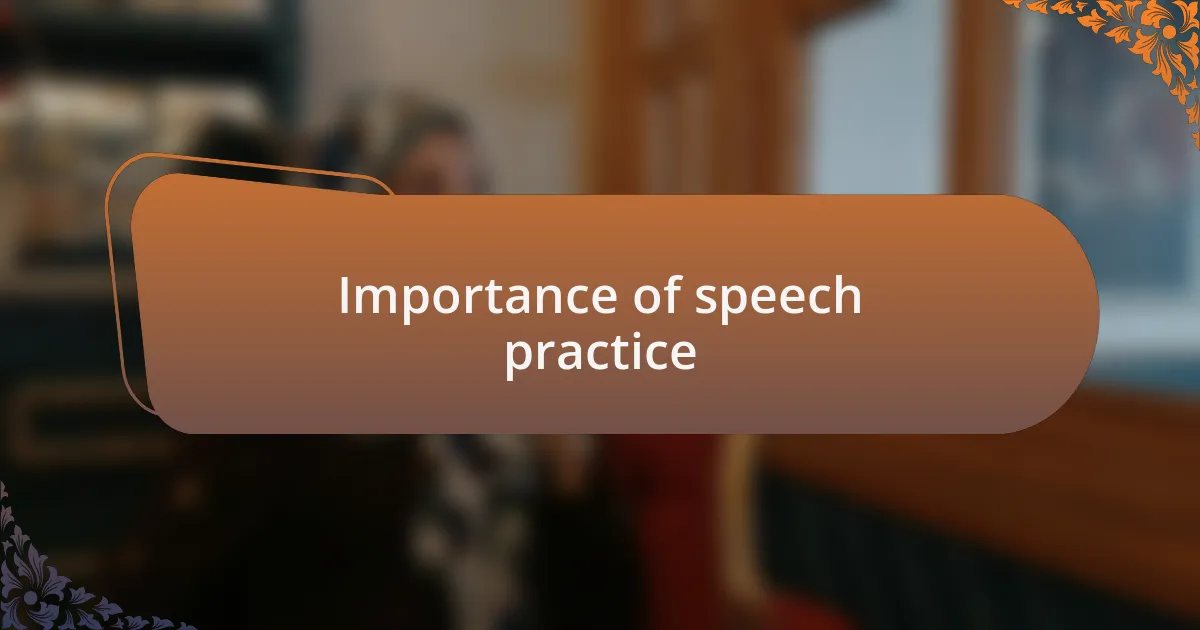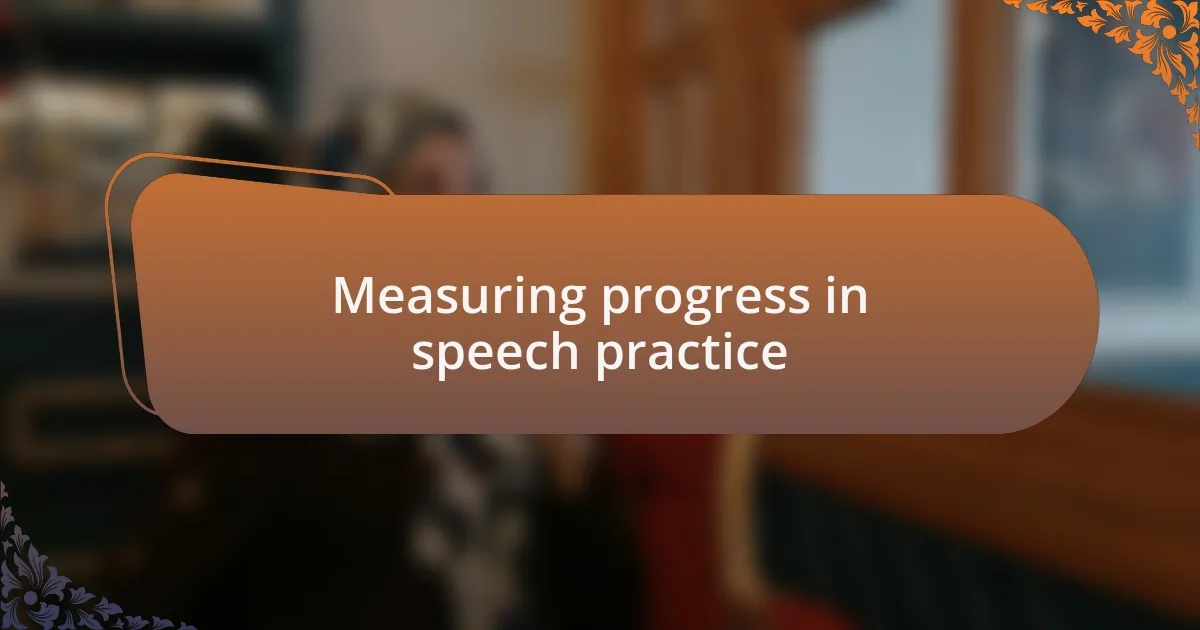Key takeaways:
- Selective mutism is an anxiety disorder, not a choice, often misunderstood as shyness.
- Regular practice in supportive environments helps build speaking confidence and reduces anxiety.
- Setting realistic, achievable speech goals and tracking progress can empower individuals in their communication journey.
- Creating a positive and supportive practice environment fosters growth and encourages self-expression.

Understanding selective mutism
Selective mutism is a complex anxiety disorder that primarily affects children, leading to a consistent inability to speak in certain social situations despite speaking comfortably in other settings. I remember a friend whose daughter would engage in animated conversations at home but suddenly fall silent when it was time to participate in class. It made me wonder: how do children navigate their worlds when communication suddenly feels impossible?
It’s crucial to understand that selective mutism isn’t a choice; it’s a real struggle that can stem from various factors, including genetics and environmental influences. When I first learned about it, I was struck by how many people misinterpret the silence as shyness or defiance, overlooking the underlying anxiety that fuels this condition. Have you ever felt that pressure of expectation, where the weight of words held you back?
Therapies such as cognitive-behavioral approaches can help children gradually gain confidence in their ability to speak in challenging environments. As I’ve seen in practice, slowly engaging with them in a one-on-one setting can lead to breakthroughs; it’s about creating safe spaces for expression. Each small victory builds on itself, showing us that understanding and patience can make a significant difference in their journey.

Importance of speech practice
Practicing speech holds significant importance for individuals facing selective mutism. When I first started practicing speaking out loud in supportive environments, it felt like a small victory each time I managed to string words together. These moments reinforced the idea that practice not only refines verbal skills but also helps to alleviate anxiety surrounding communication.
For many, the fear of speaking in certain situations can feel paralyzing. I vividly recall the first time I helped a child to practice in a familiar setting—initially, they whispered, but gradually, with each attempt, their voice grew stronger, reflecting a blossoming confidence. Isn’t it remarkable how repetition can transform fear into familiarity, making speech feel less daunting?
Moreover, engaging in speech practice allows individuals to experiment with their voices and expressions. I’ve seen firsthand how playing games that incorporate talking can break down barriers in a playful way. Have you ever noticed how play can foster a sense of safety and freedom? In a relaxed atmosphere, speech becomes less of a chore and more of a joyous exploration, helping those with selective mutism embrace their voices.

Benefits of regular speech routines
Regular speech routines are transformative. When I established a daily speaking practice, I began to notice how routine brought a sense of predictability. It was comforting to know that I had specific times to focus on my speech, which helped reduce the anxiety that often accompanied spontaneous conversations. Have you ever felt how routine can ease tension, making unfamiliar tasks feel like part of a predictable day?
Consistency in practice also builds momentum. I remember a time when I set aside just ten minutes each morning to read aloud. Initially, it felt daunting, but over time, I found my confidence swelled. Each session became a stepping stone, leading to more extended speaking opportunities. It’s fascinating how those brief moments of spoken words added up, unlocking new possibilities with each passing day.
Additionally, regular speech routines create a safe space for self-expression. I once facilitated a weekly gathering where participants shared their favorite stories. Witnessing others open up while breathing through their nervousness was inspiring. The laughter, the shared experiences—it reminded me that every voice matters. Could you imagine how powerful it is to share a piece of oneself with others? Through these routines, I found that speech not only became a skill but an avenue for connection and community.

Setting realistic speech goals
Setting realistic speech goals starts with understanding your current abilities and comfort levels. When I first began my journey, I aimed too high by wanting to participate in a group discussion right away. It quickly became clear that small, achievable goals, such as introducing myself to one new person each week, made a significant difference. Have you ever felt overwhelmed by expectations that didn’t align with your progress? Those small victories can be incredibly empowering.
Another vital aspect is breaking down larger goals into manageable steps. For instance, instead of saying, “I will speak in public,” I focused on smaller tasks like practicing in front of a mirror or recording my voice. These little achievements helped build my confidence gradually, making the larger goal feel less intimidating. How can you translate a big ambition into bite-sized tasks that feel achievable for you?
Tracking progress is equally important, as it provides a visual representation of growth. I started keeping a journal to note my speaking experiences, no matter how small. Each entry served as a reminder of how far I’d come and highlighted areas where I could improve. Have you ever reflected on your journey and realized you’ve achieved more than you thought? Seeing those small markers of progress can inspire continued efforts and remind us that every step counts in the journey toward effective communication.

Creating a supportive practice environment
Creating a supportive practice environment is essential for building confidence. I remember when I first tried practicing speech at home, but I felt overwhelmed by distractions. I found that setting up a quiet and comfortable space, free of noise and interruptions, helped me focus on my speech exercises. Have you ever noticed how your surroundings can influence your mood and performance?
In addition to a quiet space, I learned the importance of surrounding myself with understanding people. I began inviting a close friend who knew about my selective mutism to join me during practice sessions. Their encouragement and patience made a world of difference. It’s remarkable how having someone who truly listens can transform your experience. How can you find that supportive presence in your practice?
Creating a positive atmosphere extends to your mindset as well. Initially, I found myself dreading practice sessions, worrying about perfection. Over time, I shifted my perspective to view these moments as opportunities for growth, even when things didn’t go as planned. Have you ever realized that embracing imperfection can lead to breakthroughs? I discovered that celebrating small efforts, rather than focusing solely on outcomes, cultivated a more supportive and uplifting environment.

Daily activities to enhance speaking
Daily activities play a crucial role in enhancing speaking skills. I remember when I decided to incorporate storytelling into my day. Each evening, I would share a small story with my family at dinner. It felt like a safe space to practice, and their reactions encouraged me to express myself more freely. Have you ever found that sharing stories helps connect with others in a more meaningful way?
In addition to storytelling, reading aloud became a powerful tool for me. I began to select simple books that I enjoyed, and I would read a chapter each day, focusing on pronunciation and clarity. It was fascinating to see how the words flowed as my confidence grew. Have you experienced the joy of speaking more clearly through consistent practice like this?
Lastly, I introduced daily affirmations into my routine. Each morning, I would stand in front of the mirror and confidently state my goals for the day, reminding myself that I could face any speaking challenge that came my way. This ritual not only set a positive tone for my day but also gradually reinforced my belief in my ability to speak. Have you tried using affirmations to boost your confidence? They can truly make a difference in how you approach your speaking experiences.

Measuring progress in speech practice
Tracking progress in speech practice can be a rewarding experience. One method I’ve found effective is keeping a journal where I note the moments I successfully speak in different settings. I remember the pride I felt after an outing where I spoke to a cashier without hesitation. Have you ever celebrated small victories on your journey? They serve as powerful reminders of how far you’ve come.
Another useful technique is to record myself during practice sessions. Listening to those recordings helps me identify areas for improvement while also allowing me to hear my growth over time. There was a time when I couldn’t recognize my own voice, but now I can hear the clarity and confidence emerging. Doesn’t it feel encouraging to witness our own progress in such a tangible way?
Lastly, I began to involve friends in my practice, asking them for feedback on my speech. Their encouragement often reinforces my progress more than I expected. One friend’s comment about my improved articulation made all the effort worth it. Have you thought about including others in your speech practice? It can turn a solitary journey into a collaborative experience, offering motivation and accountability.